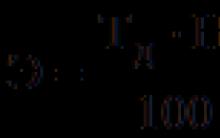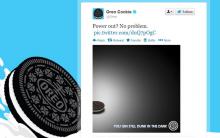Psychological effectiveness - the degree of influence of advertising on a person (attracting the attention of buyers, memorability, influencing the motive for buying, etc.). Moreover, the psychological impact is most effective if it leads potential consumers to make a purchase. Thus, the economic efficiency of advertising depends on the degree of its psychological impact on a person.
Measuring the cost-effectiveness of advertising presents great difficulties, since advertising, as a rule, does not give the full effect immediately. In addition, the growth in trade turnover is often caused by other (non-advertising) factors - for example, a change in the purchasing power of the population due to rising prices, etc. .
The economic efficiency of advertising is most often determined by measuring its impact on the development of trade. The simplest method for determining the economic efficiency of advertising is the method of comparing the turnover before and after the promotional event. According to this method, the economic efficiency of advertising is determined either by comparing the turnover for a certain period of the current year, when the product was exposed to advertising, with data for the same period last year, when the product was not advertised, or by comparing the daily turnover before and after the promotional event in the current period. time.
The latter method is more acceptable in our conditions, given the constant rise in prices due to inflation, which makes it very difficult to compare data over long periods of time.
The final conclusions about the economic efficiency of advertising are obtained by comparing the additional profit received as a result of advertising with the costs associated with its implementation.
Additional turnover under the influence of advertising is determined by the formula:
where T d -- additional turnover under the influence of advertising, rub.; T with -- the average daily turnover before the advertising period, rub.; P -- increase in the average daily turnover for the advertising and post-advertising periods,%; D - the number of days of accounting for turnover in the advertising and post-advertising periods.
The economic efficiency of advertising can also be judged by the economic result that was achieved from the use of an advertising medium or an advertising campaign. The economic result is determined by the ratio between the profit from the additional turnover received under the influence of advertising, and the cost of it.
To calculate the economic effect, you can use the following formula:
where E is the economic effect of advertising, rub.; T d -- additional turnover under the influence of advertising, rub.; H t -- trade markup for goods, in% of the selling price; U R -- advertising costs, rub.; U D -- additional costs for the growth of turnover, rub.
In this case, we compare the effect obtained from the promotional event with the costs of its implementation. The results of this ratio can be expressed in three ways:
However, the data obtained is still insufficient to compare the cost-effectiveness of spending on various promotional activities. More accurately, the cost effectiveness of advertising characterizes its profitability.
The effectiveness of the psychological impact of advertising media is characterized by the number of consumer coverage, the brightness and depth of the impression that these media leave in a person’s memory, and the degree of attention.
The effectiveness of the psychological impact of advertising on the consumer can be determined through observations, experiments, and surveys.
The method of observation is used in the study of the impact on consumers of individual advertising media. This method is passive in nature, since the observer does not influence the buyer in any way, but, on the contrary, conducts observations imperceptibly for him. According to a predetermined scheme, the observer registers the received data, which are then comprehensively analyzed. The observer, for example, notes which stand of the fair or exhibition-sale attracts the most attention of buyers, how long pedestrians linger at one or another showcase, how many people enter the store after familiarizing themselves with the showcase, which product in the showcase is of greater interest and what demand it is in .
Evaluating the effectiveness of individual advertising media, first of all, it is established whether this medium achieves its goal. So, to determine the degree of attracting the attention of buyers to outdoor advertising (showcase), you can use the following formula:
where B is the degree of attracting the attention of passers-by; About - the number of people who paid attention to outdoor advertising (showcase) during a certain period; P is the total number of people who passed by the shop window in the same period.
Along with the observation method, the experimental method is widely used. This method is active. The study of the psychological impact of advertising here takes place in conditions artificially created by the experimenter. If the observation only fixes how the consumer relates, for example, to a certain display of goods, then the experimenter can rearrange the goods, and then observe the change in the reaction of buyers.
This method is used in determining the impact on buyers of window display, packaging, press ads, radio or television advertising. So, if it is necessary to assess the psychological impact on the buyer of the product packaging, then the same product (for example, washing powder) is placed in different packages.
The survey method also refers to active methods for determining the psychological impact of advertising. This method is time-consuming, but much more reliable than others, as it allows you to identify directly from the buyer himself his attitude not only to the advertising medium as a whole, but also to the individual components of this medium. Using the survey method, you can evaluate the impact of an advertising medium on buyers and determine which elements of its design attract the most attention and are better remembered.
To determine the effectiveness of a particular advertising medium, questionnaires are drawn up, which, according to a pre-designed program, are brought to the attention of consumers in writing, in personal conversations, on radio or television. An analysis of the responses received allows us to draw appropriate generalizations and conclusions.
In some cases, surveys are combined with experiments. Sometimes the effectiveness of advertising is evaluated on the basis of voting data. The effectiveness of an advertising event or a separate means of advertising can be expressed by the number of consumers covered by advertising, as well as by the amount of costs per viewer, reader, etc. The more readers will be covered by advertising, the less will be the cost per person.
Data on the effectiveness of the psychological impact of advertising make it possible to predict its effectiveness.
Send your good work in the knowledge base is simple. Use the form below
Students, graduate students, young scientists who use the knowledge base in their studies and work will be very grateful to you.
Similar Documents
Characteristics of the commercial activity of the enterprise. Analysis of the target audience of the security systems market. The choice of advertising media and media planning criteria. Development of an advertising campaign for the company OOO "Skvid", evaluation of its economic efficiency.
term paper, added 05/11/2014
Description of the product and its properties. Description of the market situation. Advertising campaign goals. Product positioning and advertising campaign plan. Campaign budget. An example of an advertising article and a promotional video. Evaluation of the effectiveness of an advertising campaign.
term paper, added 07/11/2013
term paper, added 03/12/2015
The concept and types of an advertising campaign, the stages of its development. Consideration of the specifics of advertising public catering facilities on the example of Bulvar LLC. Characteristics of the enterprise, the formation of the budget of the advertising campaign. Evaluation of the effectiveness of activities.
thesis, added 05/11/2012
The study of the theoretical aspects of planning and conducting an advertising campaign. Analysis of the external and internal environment of BSTU "VOENMEH", determination of the specifics of the market in the field of educational services, the target audience. Planning and development of an advertising campaign.
term paper, added 05/05/2015
Theoretical foundations for the development of an advertising campaign, the advertiser's marketing programs and the characteristics of the target market segment, the definition of the target audience. The choice of means and carriers of the advertising campaign, the study of the internal and external environment of the company.
term paper, added 05/12/2010
Definition of the product category "Tablets" as an object of advertising, conducting advertising and marketing research. Formulating the goal of the advertising campaign. Definition of the target audience, advertising campaign budget, creative advertising strategy.
term paper, added 04/16/2015
Stages of planning, methods of conducting an advertising campaign. Target audience analysis. Development of a project for an advertising campaign for the body shop of CJSC "Scan-Center". Descriptions of tests for the perception and recognition of advertising. Determining the budget for marketing activities.
term paper, added 01/12/2015
Accurate calculation of the cost-effectiveness of advertising is very difficult, since this marketing tool usually does not give the full effect immediately. In addition, the growth in trade turnover is often caused by non-advertising factors - for example, a change in the purchasing power of the population due to lower prices, the expansion of the commodity distribution network, etc. Therefore, it is almost impossible to obtain accurate data on the cost-effectiveness of advertising. However, both advertisers and advertisers want to have at their disposal a means of evaluation, even if it is approximate.
To calculate the economic efficiency, advertising specialists use the following methods:
1. The ratio between the profit received from the additional turnover caused by advertising activities and advertising costs is determined by the formula:
E \u003d Td H Nt / 100 - (Zr + R) (1)
Td - additional turnover under the influence of advertising, cash units;
Нт - trade allowance for a unit of goods, % of the selling price;
P - additional costs for the increase in turnover, cash units.
The result of promotional activities can be: positive - the cost of advertising is less than the effect obtained; negative - the cost of advertising is higher than the effect obtained; neutral - the cost of advertising is equal to the effect obtained.
R \u003d P H 100 / Z, (2)
3. The economic efficiency of advertising can be identified by the method of target alternatives, by comparing planned and actual indicators, evaluated as a result of investing in an advertising campaign. Efficiency is determined by the formula:
E \u003d (Pf - Z) / (Po - Z) H 100 (3)
Pf - the actual change in the volume of profit during the period of the advertisement, monetary units;
To - the planned change in the volume of profit during the period of the advertisement, monetary units;
The effectiveness of the psychological impact of advertising media is characterized by the number of consumer coverage, the brightness and depth of the impression that these media leave in a person’s memory, and the degree of attention.
The effectiveness of the psychological impact of advertising on the consumer can be determined through observations, experiments, and surveys.
The method of observation is used in the study of the impact on consumers of individual advertising media. This method is passive in nature, since the observer does not influence the buyer in any way, but, on the contrary, conducts observations imperceptibly for him. According to a predetermined scheme, the observer registers the received data, which are then comprehensively analyzed. The observer, for example, notes which stand of the fair or exhibition-sale attracts the most attention of buyers, how long pedestrians linger at one or another showcase, how many people enter the store after familiarizing themselves with the showcase, which product in the showcase is of greater interest and what demand it is in .
The method of observation allows you to evaluate the psychological impact of advertising in natural conditions, in the direct communication of the consumer with a certain advertising medium.
Evaluating the effectiveness of individual advertising media, first of all, it is established whether this medium achieves its goal. So, to determine the degree of attracting the attention of buyers to outdoor advertising (showcase), you can use the following formula:
where B is the degree of attracting the attention of passers-by; About - the number of people who paid attention to outdoor advertising (showcase) during a certain period; P is the total number of people who passed by the shop window in the same period.
Such data can be obtained from the readings of checks punched on totalizing cash registers, and by registering the facts of the purchase of the advertised product by cashier controllers.
An indicator of the effectiveness of the means advertising the retail trade enterprise itself is the ratio of the number of visitors to the store during the period of application of these funds to the number of visitors on average per day. These data can be obtained by observers or with the help of a photocell.
When using the observation method, in all cases it is necessary to observe a number of conditions: observation should be carried out on weekdays that are not characterized by an increased intensity of customer flows (preferably in the middle of the week); the duration of observations depends on the nature of the advertising medium whose effectiveness is to be established.
Along with the observation method, the experimental method is widely used. This method is active. The study of the psychological impact of advertising here takes place in conditions artificially created by the experimenter. If the observation only fixes how the consumer relates, for example, to a certain display of goods, then the experimenter can rearrange the goods, and then observe the change in the reaction of buyers.
In the same way, the experimenter can create a variety of combinations of advertising media and, by comparing the reactions of buyers, choose the most successful of them.
Especially widespread was the study of the effectiveness of the psychological impact of advertising media through experiments in foreign countries. This method is used to determine the impact on buyers of window display, packaging, press ads, radio or television advertising. So, if it is necessary to assess the psychological impact on the buyer of the product packaging, then the same product (for example, washing powder) is placed in different packages.
The psychological effectiveness of such an advertising medium as an advertisement in a newspaper or magazine is determined by the following experiment. The advertisement includes a coupon with the text of a request to send a prospectus, catalog or sample. The buyer must cut this coupon and send it to the trading company whose address is indicated in the text of the advertisement. By the number of coupons received from readers, the advertiser judges whether his ad was noticed in the periodical press and whether the text of this ad turned out to be sufficiently convincing and interesting. However, it should be noted that the small number of requests received may not be the result of the poor quality of the ads, but the fact that the advertised product itself, for some reason, was not needed by buyers.
The survey method also refers to active methods for determining the psychological impact of advertising. This method is time-consuming, but much more reliable than others, as it allows you to identify directly from the buyer himself his attitude not only to the advertising medium as a whole, but also to the individual components of this medium. Using the survey method, you can evaluate the impact of an advertising medium on buyers and determine which elements of its design attract the most attention and are better remembered.
To determine the effectiveness of a particular advertising medium, questionnaires are drawn up, which, according to a pre-designed program, are brought to the attention of consumers in writing, in personal conversations, on radio or television. An analysis of the responses received allows us to draw appropriate generalizations and conclusions.
Conducting surveys requires a significant investment of time and the involvement of a large number of people in this work. However, the results obtained may not be sufficiently complete. Indeed, sometimes even for the buyer himself it is not clear whether he bought the goods under the influence of advertising or on the advice of a friend, or was guided by some other considerations. In addition, sometimes verbal questioning of buyers can make them wary. Therefore, it is more appropriate to invite them to fill out a questionnaire, outlining the objectives of the survey, so that the buyer knows its purpose and tries to answer the questions more accurately.
The effectiveness of an advertising event or an individual advertising medium can be expressed by the number of consumers covered by advertising, as well as by the amount of costs per viewer, reader, etc. Thus, the expediency of publishing a newspaper advertisement in a particular printed organ is determined by determining the total number of people who can read it (the number depends mainly on the circulation of the newspaper), or the cost of the advertisement per reader.
And yet, we can say a lot about the fact that economic indicators are not a measure of marketing effectiveness. But how in practice can one measure (and the effect, as I noted earlier, these are numbers) the effectiveness of an advertising campaign?
I am deliberately not talking about the effectiveness of marketing, about a long-term advertising campaign or marketing program - in these cases, the goals may be different and the effect is considered differently. But even a formula for analyzing the dynamics of sales volumes over a long period will allow marketers and financiers of an enterprise not only to evaluate the effectiveness of marketing activities in a particular period, but also to identify seasonal trends (fluctuations) in sales.
And yet, let's try to evaluate the effect of a local promotion for now. There are a number of formulas that help to accurately assess the effect of a marketing and promotional event. To begin with, let's define
What tasks do you need to cope with when advertising the subject of marketing?
regular readers have already paid attention to the fact that I constantly pay attention to the fact that it is not necessary to count something in marketing - accountants and economists do! In marketing, it is imperative to satisfy the market!But in management, understanding how effective you are in your efforts is very important.
- commercial efficiency- first, solve the problem sales growth
- communicative efficiency– secondly, digital communication indicators(the quality of communication of the subject of marketing with the market).
- economic efficiency Thirdly, you need to carry it out cost-effective(economic indicators)
Commercial Efficiency
Calculation of turnover under the influence of advertising (quantification of sales)
Making sales efforts redundant and securing a sale is the main challenge. Therefore, we consider how the turnover has changed under the influence of advertising, in relation to the turnover before advertising:T d \u003d (T s * D * P) / 100where:
T d - additional turnover caused by promotional activities, rub.;
T with - the usual average daily turnover (before the start of the advertising period), rub,;
D - the number of days of accounting for the turnover (in the period of active advertising);
P - the relative increase in the average daily turnover for the advertising period compared to pre-advertising
nmm, %.
Please note that your turnover may change and not at all because of the quality of advertising - the seasonal demand for goods has begun, there have been problems with logistics. All this and more can affect the growth of trade. For the calculation, you will need to either neglect this, or take it into account with other formulas and compensation factors.
The number of checks with the advertised product (qualitative indicator of advertising)
The indicator of the increase in the number of checks (accounts) with the product used in advertising is calculated in relation to the indicator before advertising.The amount of the advertised product in the check (qualitative indicator of advertising)
If we assume that advertising stimulates quantitative consumption, then fixing the number of goods in the basket (account) during the advertising period is also important. Just pay attention, advertising has a cumulative effect of attention to the advertised product and the effect of attenuation of attention after the cessation of advertising. How these effects affect sales can also be analyzed.Product in category
Advertised product purchases as a percentage of total purchases in the product category. Why is this indicator important? Sales of a product can grow under the influence of advertising even if category sales fall. This indicator allows you to evaluate the quality of advertising with a general drop in sales during a crisis, at the end of the season or out of season sales.
Communicative indicators of advertising effectiveness
The communicative indicators of the advertising campaign are expressed as the results of observation and analysis of the behavior of real and potential consumers. Information obtained from such observations and analysis, as well as conclusions, cannot be reduced to any standard form. Therefore, each time the report on the qualitative results of advertising effectiveness is unique in its own way.
Reach
Reach - the percentage of the target audience who viewed the advertisement during a certain period of time (the number of contacts with the target audience).
K - Number of contacts
R - The size of the audience of the advertising channel (advertising carrier) for the period of advertising
Advertising recall
Advertising recall. In response to a question about advertising a product, the respondent begins to mention specific names. For example, to the question “What television advertisements of mobile operators have you seen on television?” the respondent can answer unambiguously by naming the trademark, or he can begin to retell the content of the video. The percentage of respondents who call it out of the total number of respondents determines the quality of recall of advertising. brand awareness
Criteria such as recall or brand recognition are evaluated (depending on the goals of the ongoing advertising campaign). In the presence of both objectives, brand recall (“Which brands of mobile phones come to your mind first?”), And then recognition (“Which of these brands have you seen before?”) Is assessed first. The first measurement is carried out without prompts, the second - with prompts in the form of showing respondents images of brands (or a list of their names).Consumer actions
Actions are expressed in a behavioral response to advertising (purchase, preparation for purchase, search for additional information, ignoring, etc.). When trying to find out about the “action” by the survey method, usually those who saw the advertisement are asked the following question: “Which mobile phone stores have you recently visited?”CTR is an indicator of the communicative effectiveness of advertising, measured as the ratio of the number of certain actions in response to an advertisement (advertising clicks, store visits, leaflets handed out) to the number of impressions of this ad.
CTB is an indicator of the effectiveness of online advertising, measured as the ratio of the number of visitors to a commercial web resource attracted by advertising and making a purchase to the total number of visitors attracted by advertising. The indicator reflects the conversion of visitors and in some cases is called the conversion rate. as in the previous case, the "action" is the purchase itself (not its value).
Communicative efficiency in traditional advertising, it is much easier to measure than economic advertising.
The preliminary methods for researching the effectiveness of advertising include the following.
- 1. Direct evaluation method. It involves studying the opinions of consumers about various options for an advertising message: how much the message captured attention, whether it is easy to perceive, how clear the main idea and the advertised benefits are, what seems especially attractive in the message, how much the message causes a desire for follow-up actions, etc.
- 2. portfolio tests. It involves showing consumers a number of different advertising messages without a time limit. Respondents are then asked to recall everything they saw, including the content of the advertisements. The portfolio test is designed to identify the level of memorability of an advertising message, its ability to stand out among others.
- 3. Laboratory tests. With their help, the physiological reaction of the consumer to an advertising message is measured, and appropriate equipment is needed. They help to determine how capable the advertising message is to attract the attention of the consumer.
These methods help to preliminarily assess the possible degree of impact of an advertising message on the target audience. After that, the most proven advertising messages are selected and an advertising campaign is carried out.
- level of awareness;
- motivation level;
- impact on purchasing behavior;
- noticed - the consumer remembers that he saw an advertisement if the product is mentioned in a conversation;
- memorability - the ability not only to remember, but to correctly reproduce an advertising message;
- Recognizability - the ability to "recognize" the message when it is displayed.
When studying the communicative effectiveness of television advertising, it is often used panel method. Separate studies are conducted to determine the relationship between the frequency of advertising and the nature, as well as the level of exposure to consumers.
There are the following categories of evaluation research methods:
- memory tests - associated with tests of memory and recognition;
- persuasiveness tests - are associated with finding out from consumers before and after viewing an advertisement their intention to buy a product of a certain brand;
- counting direct responses - refers to the cost-effectiveness method and is associated with counting calls to the firm for additional information and the number of purchases under the influence of advertising;
- communication tests - designed to identify such characteristics as whether the advertisement conveyed the correct message to the target audience, how consumers reacted to this message. The results are ambiguous and require detailed analysis and interpretation;
- focus group - is the most common method of preliminary evaluation of the effectiveness of television and print advertising, highly dependent on subjective factors;
- physiological tests - based on the measurement with the help of special sensors of the physiological parameters of a person's condition: pulse, dilated pupils, various reactions;
- frame-by-frame tests - are associated with fixing the reaction of viewers to certain parts of the commercial. For example, test REAS, in which, during the showing of a commercial in a cinema, viewers must press buttons on hand-held keyboards, expressing their opinion on each part of the advertisement;
- intra-market tests - an assessment is made of the impact of an advertising campaign on sales, i.e. economic efficiency of advertising.
Economic efficiency
There are two methods (approaches) to assessing the economic efficiency of advertising:
- 1) the historical approach involves identifying the relationship between advertising costs and sales volumes for past periods of time;
- 2) the experimental approach is to study the impact of advertising costs on sales by allocating different advertising budgets for the regions in which the experiment is conducted.
To get a better idea of the potential cost-effectiveness before launching to a mass audience, its impact can be measured on the example of a small region and compare changes in sales volumes with other regions where the advertising campaign has not yet been carried out.
Relationships between advertising spending and indicators such as market share can also be used to assess economic efficiency; the number of new customers; turnover; profit, income, etc.
It is almost impossible to accurately predict the increase in sales growth as a result of an advertising campaign, since many factors influence this: the economic situation in the country and the world, the change of power in the region, changes in legislation, the prospects and current state of the market, the emergence of competitors, the emergence of new products, problems within the company, etc.
Methods for evaluating traditional communications are usually based on a sufficient amount of statistical data.
- 1. Direct methods - based on direct calculation of sales results obtained under the influence of advertising.
- 2. Indirect methods - subdivided by determining the number of customers and the number of invoices and methods for determining the amount of sales.
The amount that really needs to be allocated for advertising depends on the stage of the product life cycle, since at the stage of product introduction, trade can even be unprofitable, and advertising costs can significantly exceed the average 4-5% of all company expenses.
Measurement of the effectiveness of advertising is expressed in the study of how familiar the target audience is with information about a particular company, what is known about the goods produced by the company, their quality characteristics, what image of the company and goods has been formed and what is the attitude of potential consumers towards them.
In general, it is not possible to absolutely accurately determine the effectiveness of individual advertising media in most cases. However, preliminary calculations justify themselves.
- Marketing by notes: a practical course on Russian examples: textbook / ed. L. A. Danchenok. 3rd ed. M.: Market DS, 2008. S. 712–713.
- Marketing by notes: a practical course on Russian examples: textbook / ed. L. A. Danchenok. 3rd ed. M.: Market DS, 2008. S. 714–715.
- Vasilyeva E. A. How to make advertising effective? 25 win-win ideas: pract. allowance. Moscow: Dashkov i 1C, 2010, pp. 23–24.











Does Sberbank return tax free
Voloshin Maximilian Alexandrovich
review of the exhibition in the State Tretyakov Gallery
Positive quotes for every day
How to pay for Internet and other Rostelecom services through Sberbank online, terminals and ATMs